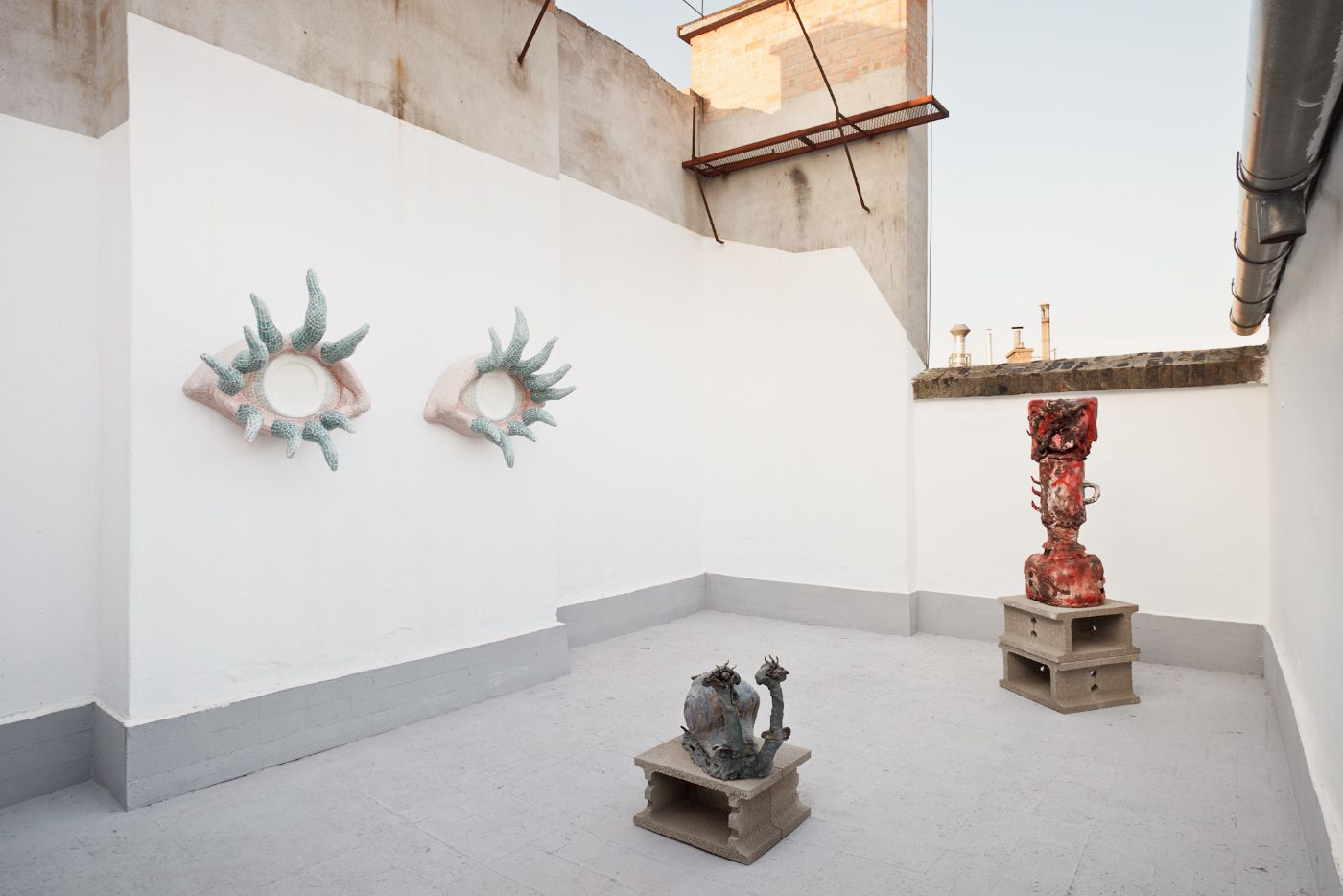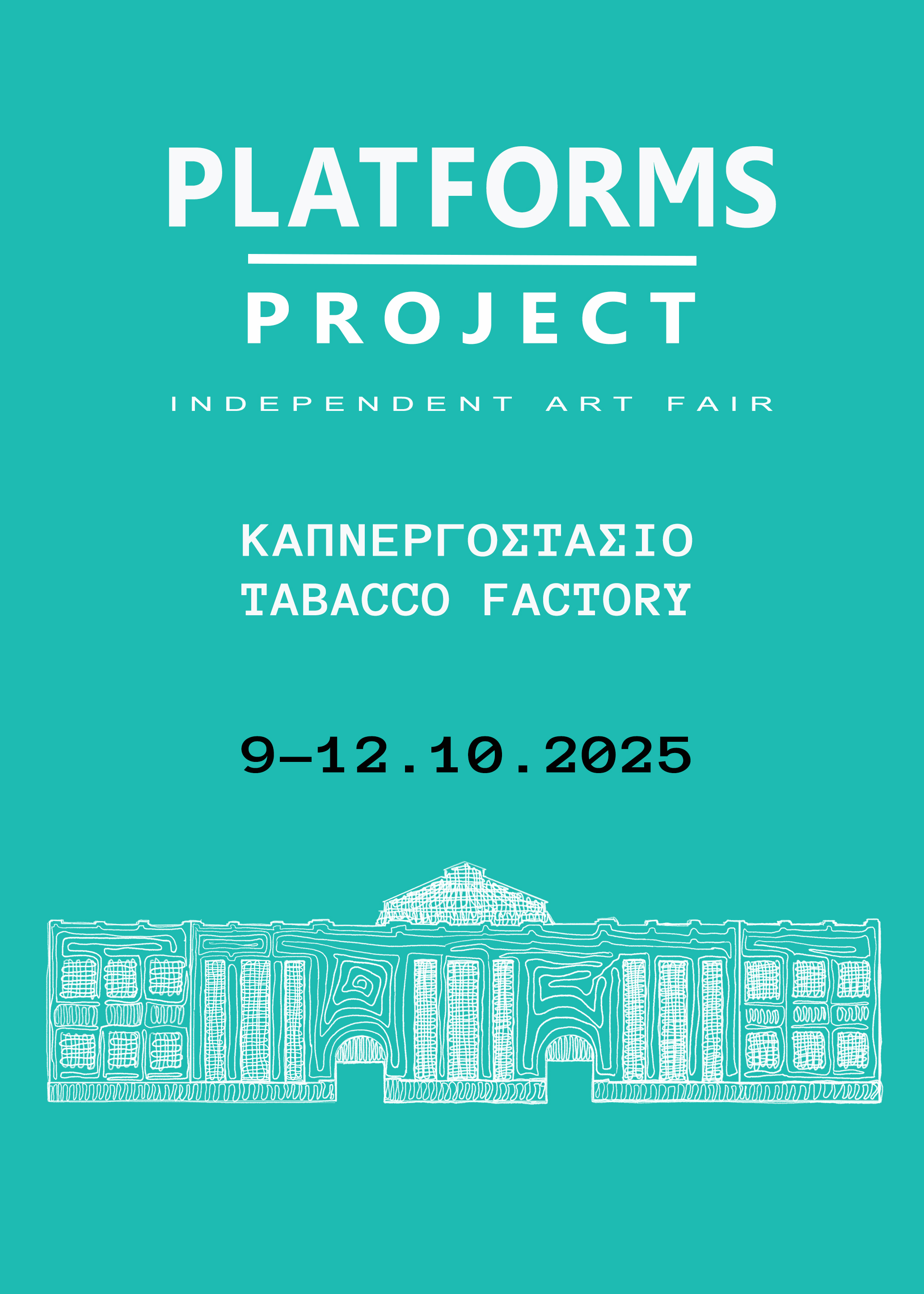In Sunbaked Thirst With Love, the open-air, rooftop gallery of ENA Viewing Space in Budapest is populated by strange creatures and mystical totemic entities by Tom Volkaert and Zsófia Keresztes. The exhibition touches upon issues of hybrid identities and virtual cannibalism, as seen through the eyes of two young European sculptors.
Belgian artist Tom Volkaert (b. 1989) works mainly with clay to create sculptures that combine organic and mineral qualities. He often creates totemic objects that stand like enigmatic signals for deities of lost civilisations, but which at the same time seem to squirm with living tendrils, tissues and teeth.
In that sense, his sculptures can be read as an amalgamation of biological life and the artificial: not quite like cyborgs, but as fantastical organisms that have a twisted symbiotic relationship with an apparatus whose function and origin is lost to us. The show’s curator Peter Bencze describes these works as “post-life”, exactly in order to stress that they can be understood as objects from “lost civilisations" with “ideologies that are foreign” to us, and which “distort” what we would find familiar in their lifelike properties. Volkaert’s creations are indeed alien, but in a humorous, space-cowboy kind of way.

The work of Hungarian artist Zsófia Keresztes (b. 1985) explores the theme of virtual cannibalism through sculptures that merge the digital world with the human body. Her most recent works are made of curvaceous forms of expanded polystyrene covered with soft-coloured glass tesserae, often combined with copper rods and strands of hair to create complex structures with uncanny narratives.
Previously (as seen for example in her User Experience series from 2015), Keresztes has used the packaging of commercial computers and other digital devices to create sculptures that explode the packaging’s images into surreal instances where nature, industry and the digital experience are interlocked into a dynamic queer coexistence. It is important to point out that the works in the User Experience series blur the hierarchy between host and guest: it is equally possible that the computer screens are consuming their surroundings, and the other way round.
In recent years, Keresztes has been using the contents of such packaging (namely expanded polystyrene) to create large organic forms that in some cases are anthropomorphic and monumental in scale. As such, Keresztes’s latest sculptures are like mutations of humanity congested by technology, with polystyrene taking the shape of limbs and muscles covered with hundreds of tiny screens in the appealing colours of iMac and Samsung screensavers.

Sunbaked Thirst With Love includes a large sculpture by Keresztes of two intertwined human forms picking each other with forks and a pair of voracious eyes, both works alluding to virtual cannibalism and how we allow our digital devices to devour our bodies and minds. These are in dialogue with Volkaert’s sculptures, which reflect the artist’s sense of humour and ability to combine the comical with the grotesque—as seen for example in a “sunburnt” clay totem that is glazed in bright red, a “petrified” bowl of soup and a sculpture of a snail that, according to Bencze, symbolises the struggle of young artists and their slow progress in the world.
Instead of a conventional exhibition text, the curator provides a poetic and brief description of all the works at the exhibition as follows:
Weights of empathy as metaphor for heavy tears,
Smiling ashtray standing on two legs,
Eyes like carnivorous plants with empty belly,
Chasing the snail, which will make it to the finish line (anyway),
Sunburnt red totem with claws in the corner,
Guarded by thirsty twins on top,
Facing with a petrified bowl of Minestrone.
Images of hunger, thirst and raptorial behaviour abound, as seen in Keresztes’s wall-mounted “carnivorous” eyes and Volkaert’s totem with claws. However, the works seem hardly intimidating due to their playfulness and strong sense of irony. Both artists deal with a strange union between biological and artificial components, something that manifests as animalistic symbiosis in Volkaert and blissful ingestion and surrender in Keresztes.

In her paper Representing the Feminine Cannibal, Juliet Davis points out that virtual cannibalism can work in a destructive or a transformative way. In the case of human beings’s relationship with the virtual world, we are either fragmented or enveloped by our digital experiences. And although this process is often associated with violence, it can become “a possible model of wholeness”. For Davis, cyber-cannibalism can become “a regenerative process”.
Following Davis’s ideas, we could understand Keresztes’s plump screen-covered mutants as half-digital, half-human beings that have emerged from cyberspace after consuming its human users. They stand as instances of a kind of virtual cannibalism that is in fact pregnant with a post-humanness that has surrendered itself into the digital world. Likewise, Volkaert’s weird totems and creatures are also mutant and the result of a weird mix of human and artificial, only in his case this symbiosis takes a much less streamlined and peaceful form. In Keresztes, it’s sleek corporate marketing coercing us to desire to be devoured. In Volkaert, it’s bloodthirsty cyborg gods demanding sacrifice to feed on our self-destructive obsession with them.
Resources
Davis, Juliet. Representing the Feminine Cannibal. Link: http://www.julietdavis.com/papers/femininecannibal/index.html. Accessed 17 August 2019.
Morse, Margaret. What Do Cyborgs Eat?: Oral Logic in an Information Society. Discourse, Vol. 16, No. 3 (Spring 1994), pp. 86-123. Wayne State University Press.



















